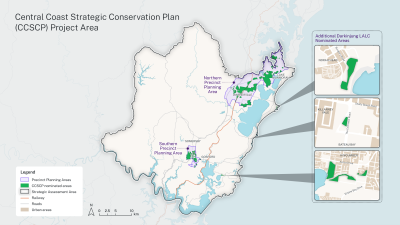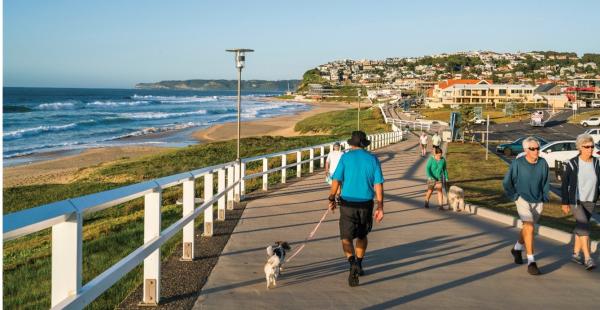The Department is developing a plan for the Central Coast to enable development on suitable land for housing and jobs, while protecting the region’s unique native plants and animals. The plan will identify where development can occur and what areas must be protected.
Covering around 3,000 hectares, the plan supports the goals of the Central Coast Regional Plan 2041 and includes land owned by the Darkinjung Local Aboriginal Land Council. It is a joint initiative between the NSW and Australian Governments.
Terms of reference
- We have finalised the terms of reference under section 146(1B)(b)(iii) of the Australian Government’s Environment Protection and Biodiversity Conservation Act 1999.
- The terms of reference explain how the impacts of development on plants and animals protected under the Act are assessed.
- The terms of reference do not include details of the conservation plan or information on individual landowner property mapping.
- The terms of reference were finalised after public exhibition for feedback, open from 15 November 2024 to 10 January 2025.
- The terms of reference will inform the draft Central Coast Strategic Conservation Plan and strategic assessment report, which will be exhibited for public feedback in 2025.
- The public exhibition of these documents will be the formal opportunity for the public to comment on the conservation plan.
- The final conservation plan will then be submitted for approval by both State and Commonwealth Governments.
For more information email [email protected]
Frequently asked questions
What is the purpose of the conservation plan?
What is the purpose of the conservation plan?
The plan will enable development on suitable land while protecting the region’s unique native plants and animals. It will do this by identifying areas that can and can’t be developed through biodiversity approvals. This will be in line with state and federal legislation. This will help protect high biodiversity value land, streamline appropriate development by removing the need for individual site assessments for biodiversity and ensure a strategic approach to delivering biodiversity offsets that support ecosystem function.
Land covered by the conservation plan has been identified for growth under the Central Coast Regional Plan 2041 and the Darkinjung Local Aboriginal Land Council’s development delivery plan.
Why is a conservation plan needed?
Why is a conservation plan needed?
As we develop more homes and critical infrastructure, it is vital we protect our plants and animals. A conservation plan is needed for the Central Coast to balance the need for development with the protection of biodiversity. As the population increases, the plan will deliver much needed housing in the area while contributing to healthier local communities and environments.
Rather than site-by-site approvals, the conservation plan will consider the cumulative impacts of growth on the area over the long term, identifying which areas can be developed and which should be protected. This will speed up development application approval times, delivering more homes faster while also allowing targeted conservation actions that counterbalance development to be delivered
The plan is being developed in response to the Central Coast Strategy for Economic Growth and supports the objectives of the Central Coast Regional Plan 2041.
What areas does the conservation plan cover?
What areas does the conservation plan cover?
Land within the Greater Warnervale, Greater Lake Munmorah and Somersby growth areas and precincts, as identified in the Central Coast Regional Plan 2041. It also includes several sites owned by Darkinjung Local Aboriginal Land Council.

What are the next steps in developing the conservation plan?
What are the next steps in developing the conservation plan?
Publicly exhibiting the draft terms of reference under the Environment Protection and Biodiversity Conservation Act 1999 was an important step in developing the plan.
Now that the terms of reference have been finalised, we will complete the draft strategic assessment report and draft Central Coast Strategic Conservation Plan. We will publicly exhibit these for feedback in 2025.
The draft conservation plan will identify land where development is suitable. It will also identify areas of high biodiversity value where development must be avoided. The plan will outline a conservation program to balance the impacts of growth.
Your feedback on the draft documents is important. All feedback will be considered before the final plan is submitted to the state and federal environment ministers for consideration and approval.
